
Boroughs and localities of Berlin
Encyclopedia
Berlin
is both a city and one of Germany
’s federal states
. It is made up of twelve boroughs (Bezirke in German, also known as districts or administrative districts in English), each with its own borough government, though all boroughs are subject to Berlin’s city and state government.
, forming the basis for the present-day city and state. The localities do not have their own governmental bodies, but are recognized by the city and the boroughs for planning and statistical purposes. Berliners often identify more with the locality where they live than with the borough that governs them. The localities are further subdivided into statistical tracts, which are mainly used for planning and statistical purposes. The statistical tracts correspond roughly but not exactly with neighbourhoods recognized by residents.
When Greater Berlin was established in 1920, the city was organized into 20 boroughs, most of which were named after their largest component locality, often a former city or municipality; others, such as Kreuzberg
and Prenzlauer Berg
, were named for geographic features. By 2000, Berlin comprised 23 boroughs, as three new boroughs had been created in East Berlin
.
An administrative reform in 2001 merged the existing boroughs into the current 12 boroughs. As of 2005, these 12 boroughs were made up of a total of 95 officially recognized localities, as listed below.
 All the coats of arms of Berliner boroughs (the current as the ones in the period 1990-2001) have some common points: The shield has a Spanish form and the coronet
All the coats of arms of Berliner boroughs (the current as the ones in the period 1990-2001) have some common points: The shield has a Spanish form and the coronet
is represented by a mural crown
: 3 towers in red bricks with the coat of arms of Berlin
in the middle.
Most of the coats of arms of current boroughs have changed some elements in their field
: Some of them have created a "fusion" of themes of the merged Bezirke (Charlottenburg-Wilmersdorf, Lichtenberg, Steglitz-Zehlendorf, Tempelhof-Schöneberg); others have modified their themes taken from one of the two (or more) former merged boroughs (Friedrichshain-Kreuzberg, Marzahn-Hellersdorf, Mitte and Treptow-Köpenick). Only the unchanged boroughs of Neukölln, Reinickendorf and Spandau haven't changed their field. The coat of arms of Pankow was created with a new design in 2008, having been the only district without an emblem for 7 years.
as Ortslagen, Teile, Stadtviertel, Orte etc.). The largest Ortsteil is Köpenick
(34.9 km² (13.5 sq mi)), the smallest one is Hansaviertel
(53 ha (131 acre)). The most populated is Neukölln
(154,127 inhabitants in 2009), the least populated is Malchow
(450 inhabitants in 2008).
(01) Mitte
(02) Friedrichshain-Kreuzberg
(03) Pankow
(04) Charlottenburg-Wilmersdorf
(05) Spandau
(06) Steglitz-Zehlendorf
(07) Tempelhof-Schöneberg
(08) Neukölln
(09) Treptow-Köpenick
(10) Marzahn-Hellersdorf
(11) Lichtenberg
(12) Reinickendorf
Berlin
Berlin is the capital city of Germany and is one of the 16 states of Germany. With a population of 3.45 million people, Berlin is Germany's largest city. It is the second most populous city proper and the seventh most populous urban area in the European Union...
is both a city and one of Germany
Germany
Germany , officially the Federal Republic of Germany , is a federal parliamentary republic in Europe. The country consists of 16 states while the capital and largest city is Berlin. Germany covers an area of 357,021 km2 and has a largely temperate seasonal climate...
’s federal states
States of Germany
Germany is made up of sixteen which are partly sovereign constituent states of the Federal Republic of Germany. Land literally translates as "country", and constitutionally speaking, they are constituent countries...
. It is made up of twelve boroughs (Bezirke in German, also known as districts or administrative districts in English), each with its own borough government, though all boroughs are subject to Berlin’s city and state government.
History
Each borough is made up of several officially recognized localities (Ortsteile in German, sometimes called subdistricts in English). These localities typically have a historical identity as former independent cities, villages, or rural municipalities that were united in 1920 as part of the Greater Berlin ActGreater Berlin Act
The Greater Berlin Act , in full the Law Regarding the Reconstruction of the New Local Authority of Berlin , was a law passed by the Prussian government in 1920 that greatly expanded the size of the German capital of Berlin.-History:...
, forming the basis for the present-day city and state. The localities do not have their own governmental bodies, but are recognized by the city and the boroughs for planning and statistical purposes. Berliners often identify more with the locality where they live than with the borough that governs them. The localities are further subdivided into statistical tracts, which are mainly used for planning and statistical purposes. The statistical tracts correspond roughly but not exactly with neighbourhoods recognized by residents.
When Greater Berlin was established in 1920, the city was organized into 20 boroughs, most of which were named after their largest component locality, often a former city or municipality; others, such as Kreuzberg
Kreuzberg
Kreuzberg, a part of the combined Friedrichshain-Kreuzberg borough located south of Mitte since 2001, is one of the best-known areas of Berlin...
and Prenzlauer Berg
Prenzlauer Berg
Prenzlauer Berg is a locality of Berlin, in the borough of Pankow.Until 2001, Prenzlauer Berg was a borough of Berlin; in that year it was included in the borough of Pankow....
, were named for geographic features. By 2000, Berlin comprised 23 boroughs, as three new boroughs had been created in East Berlin
East Berlin
East Berlin was the name given to the eastern part of Berlin between 1949 and 1990. It consisted of the Soviet sector of Berlin that was established in 1945. The American, British and French sectors became West Berlin, a part strongly associated with West Germany but a free city...
.
An administrative reform in 2001 merged the existing boroughs into the current 12 boroughs. As of 2005, these 12 boroughs were made up of a total of 95 officially recognized localities, as listed below.
| Borough | Population Population A population is all the organisms that both belong to the same group or species and live in the same geographical area. The area that is used to define a sexual population is such that inter-breeding is possible between any pair within the area and more probable than cross-breeding with individuals... 31 March 2010 |
Area Area Area is a quantity that expresses the extent of a two-dimensional surface or shape in the plane. Area can be understood as the amount of material with a given thickness that would be necessary to fashion a model of the shape, or the amount of paint necessary to cover the surface with a single coat... in km² |
Density Population density Population density is a measurement of population per unit area or unit volume. It is frequently applied to living organisms, and particularly to humans... per km² |
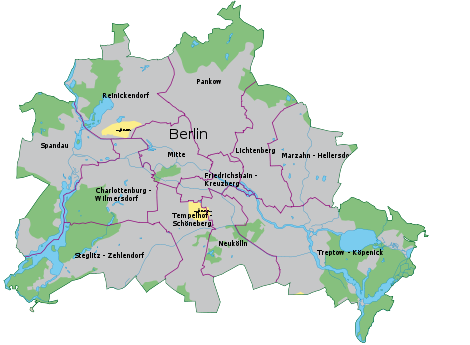 |
|---|---|---|---|---|
| Charlottenburg-Wilmersdorf Charlottenburg-Wilmersdorf Charlottenburg-Wilmersdorf is the fourth borough of Berlin, formed in the 2001 administrative reform by merging the former boroughs of Charlottenburg and Wilmersdorf.-Overview:Charlottenburg-Wilmersdorf covers the western centre of the City of Berlin... |
||||
| Friedrichshain-Kreuzberg Friedrichshain-Kreuzberg Friedrichshain-Kreuzberg is the second borough of Berlin, formed in 2001 by merging the former East Berlin borough of Friedrichshain and the former West Berlin borough of Kreuzberg... |
||||
| Lichtenberg Lichtenberg Lichtenberg is the eleventh borough of Berlin, Germany. In Berlin's 2001 administrative reform it absorbed the former borough of Hohenschönhausen.-Overview:... |
||||
| Marzahn-Hellersdorf Marzahn-Hellersdorf Marzahn-Hellersdorf is the tenth borough of Berlin, formed in 2001 by merging the former boroughs of Marzahn and Hellersdorf.-Geography:It is situated in the northeast of Berlin... |
||||
| Mitte Mitte Mitte is the first and most central borough of Berlin. It was created in Berlin's 2001 administrative reform by the merger of the former districts of Mitte proper, Tiergarten and Wedding; the resulting borough retained the name Mitte. It is one of the two boroughs which comprises former West and... |
||||
| Neukölln Neukölln Neukölln is the eighth borough of Berlin, located in the southeastern part of the city and was part of the former American sector under the Four-Power occupation of the city... |
||||
| Pankow Pankow Pankow is the third borough of Berlin. In Berlin's 2001 administrative reform it was merged with the former boroughs of Prenzlauer Berg and Weißensee; the resulting borough retained the name Pankow.- Overview :... |
||||
| Reinickendorf Reinickendorf Reinickendorf is the twelfth borough of Berlin. It encompasses the northwest of the city area, including the Berlin-Tegel Airport, Lake Tegel, spacious settlements of detached houses as well as housing estates like Märkisches Viertel.-Subdivision:... |
||||
| Spandau Spandau Spandau is the fifth of the twelve boroughs of Berlin. It is the fourth largest and westernmost borough, situated at the confluence of the Havel and Spree rivers and along the western bank of the Havel, but the least populated.-Overview:... |
||||
| Steglitz-Zehlendorf Steglitz-Zehlendorf Steglitz-Zehlendorf is the sixth borough of Berlin, formed in Berlin's 2001 administrative reform by merging the former boroughs of Steglitz and Zehlendorf.-Demographics:... |
||||
| Tempelhof-Schöneberg Tempelhof-Schöneberg Tempelhof-Schöneberg is the seventh borough of Berlin, formed in 2001 by merging the former boroughs of Tempelhof and Schöneberg.-Geography:... |
||||
| Treptow-Köpenick Treptow-Köpenick Treptow-Köpenick is the ninth borough of Berlin, Germany, formed in Berlin's 2001 administrative reform by merging the former boroughs of Treptow and Köpenick.-Overview:... |
Coats of arms

Coronet
A coronet is a small crown consisting of ornaments fixed on a metal ring. Unlike a crown, a coronet never has arches.The word stems from the Old French coronete, a diminutive of coronne , itself from the Latin corona .Traditionally, such headgear is – as indicated by the German equivalent...
is represented by a mural crown
Mural crown
-Usage in ancient times:In Hellenistic culture, a mural crown identified the goddess Tyche, the embodiment of the fortune of a city, familiar to Romans as Fortuna...
: 3 towers in red bricks with the coat of arms of Berlin
Coat of arms of Berlin
The coat of arms of Berlin is used by the German city state as well as the city itself, while Berlin's various boroughs use their own emblems. The bear was not the original symbol of the city, but instead had to 'struggle' to establish its place as such...
in the middle.
Most of the coats of arms of current boroughs have changed some elements in their field
Field (heraldry)
In heraldry, the background of the shield is called the field. The field is usually composed of one or more tinctures or furs. The field may be divided or may consist of a variegated pattern....
: Some of them have created a "fusion" of themes of the merged Bezirke (Charlottenburg-Wilmersdorf, Lichtenberg, Steglitz-Zehlendorf, Tempelhof-Schöneberg); others have modified their themes taken from one of the two (or more) former merged boroughs (Friedrichshain-Kreuzberg, Marzahn-Hellersdorf, Mitte and Treptow-Köpenick). Only the unchanged boroughs of Neukölln, Reinickendorf and Spandau haven't changed their field. The coat of arms of Pankow was created with a new design in 2008, having been the only district without an emblem for 7 years.
| Charlottenburg-Wilmersdorf Charlottenburg-Wilmersdorf Charlottenburg-Wilmersdorf is the fourth borough of Berlin, formed in the 2001 administrative reform by merging the former boroughs of Charlottenburg and Wilmersdorf.-Overview:Charlottenburg-Wilmersdorf covers the western centre of the City of Berlin... |
Friedrichshain-Kreuzberg Friedrichshain-Kreuzberg Friedrichshain-Kreuzberg is the second borough of Berlin, formed in 2001 by merging the former East Berlin borough of Friedrichshain and the former West Berlin borough of Kreuzberg... |
Lichtenberg Lichtenberg Lichtenberg is the eleventh borough of Berlin, Germany. In Berlin's 2001 administrative reform it absorbed the former borough of Hohenschönhausen.-Overview:... |
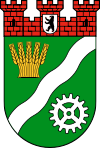 Marzahn-Hellersdorf Marzahn-Hellersdorf Marzahn-Hellersdorf is the tenth borough of Berlin, formed in 2001 by merging the former boroughs of Marzahn and Hellersdorf.-Geography:It is situated in the northeast of Berlin... |
 Mitte Mitte Mitte is the first and most central borough of Berlin. It was created in Berlin's 2001 administrative reform by the merger of the former districts of Mitte proper, Tiergarten and Wedding; the resulting borough retained the name Mitte. It is one of the two boroughs which comprises former West and... |
Neukölln Neukölln Neukölln is the eighth borough of Berlin, located in the southeastern part of the city and was part of the former American sector under the Four-Power occupation of the city... |
Pankow Pankow Pankow is the third borough of Berlin. In Berlin's 2001 administrative reform it was merged with the former boroughs of Prenzlauer Berg and Weißensee; the resulting borough retained the name Pankow.- Overview :... |
Reinickendorf Reinickendorf Reinickendorf is the twelfth borough of Berlin. It encompasses the northwest of the city area, including the Berlin-Tegel Airport, Lake Tegel, spacious settlements of detached houses as well as housing estates like Märkisches Viertel.-Subdivision:... |
 Spandau Spandau Spandau is the fifth of the twelve boroughs of Berlin. It is the fourth largest and westernmost borough, situated at the confluence of the Havel and Spree rivers and along the western bank of the Havel, but the least populated.-Overview:... |
Steglitz-Zehlendorf Steglitz-Zehlendorf Steglitz-Zehlendorf is the sixth borough of Berlin, formed in Berlin's 2001 administrative reform by merging the former boroughs of Steglitz and Zehlendorf.-Demographics:... |
 Tempelhof-Schöneberg Tempelhof-Schöneberg Tempelhof-Schöneberg is the seventh borough of Berlin, formed in 2001 by merging the former boroughs of Tempelhof and Schöneberg.-Geography:... |
 Treptow-Köpenick Treptow-Köpenick Treptow-Köpenick is the ninth borough of Berlin, Germany, formed in Berlin's 2001 administrative reform by merging the former boroughs of Treptow and Köpenick.-Overview:... |
List of localities
The 12 boroughs (Bezirke) are subdivided into 95 localities (Ortsteile). Almost all of them are subdivided into some other zones (defined in GermanGerman language
German is a West Germanic language, related to and classified alongside English and Dutch. With an estimated 90 – 98 million native speakers, German is one of the world's major languages and is the most widely-spoken first language in the European Union....
as Ortslagen, Teile, Stadtviertel, Orte etc.). The largest Ortsteil is Köpenick
Köpenick
Köpenick is a historic town and locality that is situated at the confluence of the rivers Dahme and Spree in the south-east of the German capital city of Berlin. It was formerly known as Copanic and then Cöpenick, only officially adopting the current spelling in 1931...
(34.9 km² (13.5 sq mi)), the smallest one is Hansaviertel
Hansaviertel
The Hansaviertel is a small locality between Großer Tiergarten park and the Spree river within the central Mitte borough of Berlin...
(53 ha (131 acre)). The most populated is Neukölln
Neukölln (locality)
Neukölln is an inner-city locality of Berlin in the homonymous borough of Neukölln, including the historic village of Rixdorf and numerous Gründerzeit apartment blocks. The Ortsteil is densely settled a with a population of 154,127 inhabitants and is the most populated one of Berlin...
(154,127 inhabitants in 2009), the least populated is Malchow
Malchow (Berlin)
Malchow is a German locality in the borough of Lichtenberg, Berlin. Until 2001 it was part of the former Hohenschönhausen borough. With a population of 450 it is the least-populated Berliner Ortsteil.-History:...
(450 inhabitants in 2008).
(01) Mitte
Mitte
Mitte is the first and most central borough of Berlin. It was created in Berlin's 2001 administrative reform by the merger of the former districts of Mitte proper, Tiergarten and Wedding; the resulting borough retained the name Mitte. It is one of the two boroughs which comprises former West and...
| Locality | Area in km² |
Population as of 2008 |
Density inhabitants per km² |
|
|---|---|---|---|---|
| (0101) Mitte Mitte (locality) Mitte is a central locality of Berlin in the homonymous district of Mitte. Until 2001 it was itself an autonomous district.... |
10.70 | 79,582 | 7,445 | |
| (0102) Moabit Moabit Moabit is an inner city locality of Berlin. Since Berlin's 2001 administrative reform it belongs to the newly regrouped governmental borough of Mitte. Previously, from 1920 to 2001, it belonged to the borough of Tiergarten. Moabit's borders are defined by three watercourses, the Spree, the... |
7.72 | 69,425 | 8,993 | |
| (0103) Hansaviertel Hansaviertel The Hansaviertel is a small locality between Großer Tiergarten park and the Spree river within the central Mitte borough of Berlin... |
0.53 | 5,889 | 11,111 | |
| (0104) Tiergarten Tiergarten Tiergarten is a locality within the borough of Mitte, in central Berlin . Notable for the great and homonymous urban park, before German reunification, it was a part of West Berlin... |
5.17 | 12,486 | 2,415 | |
| (0105) Wedding Wedding (Berlin) Wedding is a locality in the borough of Mitte, Berlin, Germany and was a separate borough in the north-western inner city until it was fused with Tiergarten and Mitte in Berlin's 2001 administrative reform... |
9.23 | 76,363 | 8,273 | |
| (0106) Gesundbrunnen Gesundbrunnen Gesundbrunnen is a locality of Berlin in the borough of Mitte. It was created as a separate entity by the 2001 administrative reform, formerly the eastern half of the former Wedding district and locality... |
6.13 | 82,729 | 13,496 |
(02) Friedrichshain-Kreuzberg
Friedrichshain-Kreuzberg
Friedrichshain-Kreuzberg is the second borough of Berlin, formed in 2001 by merging the former East Berlin borough of Friedrichshain and the former West Berlin borough of Kreuzberg...
| Locality | Area in km² |
Population as of 2008 |
Density inhabitants per km² |
|
|---|---|---|---|---|
| (0201) Friedrichshain Friedrichshain Friedrichshain is a part of Berlin's borough of Friedrichshain-Kreuzberg, and like Kreuzberg across the river it has its own distinct character, with the result that the new double name is hardly ever used outside government administration. From its creation in 1920 until Berlin's 2001... |
9.78 | 114,050 | 11,662 | |
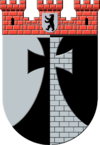 (0202) Kreuzberg (0202) KreuzbergKreuzberg Kreuzberg, a part of the combined Friedrichshain-Kreuzberg borough located south of Mitte since 2001, is one of the best-known areas of Berlin... |
10.40 | 147,227 | 14,184 |
(03) Pankow
Pankow
Pankow is the third borough of Berlin. In Berlin's 2001 administrative reform it was merged with the former boroughs of Prenzlauer Berg and Weißensee; the resulting borough retained the name Pankow.- Overview :...
| Locality | Area in km² |
Population as of 2008 |
Density inhabitants per km² |
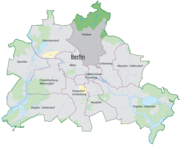 |
|---|---|---|---|---|
| (0301) Prenzlauer Berg Prenzlauer Berg Prenzlauer Berg is a locality of Berlin, in the borough of Pankow.Until 2001, Prenzlauer Berg was a borough of Berlin; in that year it was included in the borough of Pankow.... |
11.00 | 142,319 | 12,991 | |
| (0302) Weißensee | 7.93 | 45,485 | 5,736 | |
| (0303) Blankenburg Blankenburg (Berlin) Blankenburg is a German locality within the borough of Pankow, Berlin. Until 2001 it was part of the former borough of Weißensee.-History:... |
6.03 | 6,550 | 1,086 | |
| (0304) Heinersdorf | 3.95 | 6,580 | 1,666 | |
| (0305) Karow Karow (Berlin) Karow is a German locality within the Berlin borough of Pankow. Until 2001 it was part of the former Weißensee borough.-History:The locality was founded in 1375 with the name of Kare... |
6.65 | 18,258 | 2,746 | |
| (0306) Stadtrandsiedlung Malchow Stadtrandsiedlung Malchow Stadtrandsiedlung Malchow is a German locality within the Berlin borough of Pankow. Until 2001 it was part of the former Weißensee borough.-History:... |
5.68 | 1,166 | 205 | |
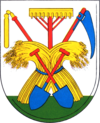 (0307) Pankow (0307) PankowPankow (locality) Pankow is a locality of Berlin in the district of Pankow. Until 2001 it was an autonomous district with the localities of Niederschönhausen, Wilhelmsruh, Rosenthal, Blankenfelde, Buch and Französisch Buchholz.-History:... |
5.66 | 55,854 | 9,868 | |
| (0308) Blankenfelde Blankenfelde Blankenfelde is a German locality within the Berlin borough of Pankow. Per population density it is the lesser one into the city .-History:... |
13.40 | 1,917 | 144 | |
| (0309) Buch Buch (Berlin) Buch is a German locality within the Berlin borough of Pankow.-History:The village was founded in 1347, on Panke river, a tributary of Spree . Until 1920 Buch was a Brandenburger municipalty merged in Berlin with the "Greater Berlin Act"... |
18.20 | 13,188 | 727 | |
| (0310) Französisch Buchholz Französisch Buchholz Französisch Buchholz , also known simply as Buchholz, is a German locality within the Berlin borough of Pankow.-History:... |
12.00 | 18,766 | 1,560 | |
| (0311) Niederschönhausen Niederschönhausen Niederschönhausen is a German locality within the borough of Pankow, Berlin. It is commonly known also as "Pankow-Schönhausen".-History:... |
6.49 | 26,903 | 4,145 | |
| (0312) Rosenthal Rosenthal (Berlin) Rosenthal is an affluent locality within the Berlin borough of Pankow. The old village first mentioned in a 1356 deed as Rosendalle became a part of Greater Berlin in 1920 .-Overview:The Rosenthal locality includes the Nordend neighborhood.... |
4.90 | 8,933 | 1,823 | |
| (0313) Wilhelmsruh Wilhelmsruh Wilhelmsruh is a German locality within the borough of Pankow, Berlin. It is the littlest locality of the city after Halensee and Hansaviertel.-History:... |
1.37 | 7,216 | 5,267 |
(04) Charlottenburg-Wilmersdorf
Charlottenburg-Wilmersdorf
Charlottenburg-Wilmersdorf is the fourth borough of Berlin, formed in the 2001 administrative reform by merging the former boroughs of Charlottenburg and Wilmersdorf.-Overview:Charlottenburg-Wilmersdorf covers the western centre of the City of Berlin...
| Locality | Area in km² |
Population as of 2008 |
Density inhabitants per km² |
|
|---|---|---|---|---|
| (0401) Charlottenburg Charlottenburg Charlottenburg is a locality of Berlin within the borough of Charlottenburg-Wilmersdorf, named after Queen consort Sophia Charlotte... |
10.60 | 118,704 | 11,198 | |
| (0402) Wilmersdorf Wilmersdorf Wilmersdorf is an inner city locality of Berlin, formerly a borough by itself but since Berlin's 2001 administrative reform a part of the new borough of Charlottenburg-Wilmersdorf.-History:... |
7.16 | 92,815 | 12,963 | |
| (0403) Schmargendorf Schmargendorf Schmargendorf is a south-western locality of Berlin in the district of Charlottenburg-Wilmersdorf. Until 2001 it was part of the former district of Wilmersdorf.-History:... |
3.59 | 19,750 | 5,501 | |
 (0404) Grunewald (0404) GrunewaldGrunewald Grunewald is a locality within the Berliner borough of Charlottenburg-Wilmersdorf. Famous for the homonymous forest, until 2001 administrative reform it was part of the former district of Wilmersdorf.-Geography:The locality is situated in the western side of the city and is separated from... |
22.30 | 10,014 | 448 | |
 (0405) Westend (0405) WestendWestend (Berlin) Westend is a locality of the Berlin borough Charlottenburg-Wilmersdorf situated on the Spandauer Berg, the northern peak of the Teltow plateau between the river valleys of Spree and Havel... |
13.50 | 37,883 | 2,800 | |
 (0406) Charlottenburg-Nord (0406) Charlottenburg-NordCharlottenburg-Nord Charlottenburg-Nord is a neighborhood in the northern part of the district Charlottenburg-Wilmersdorf, Berlin, Germany. As of 2008 its population was of 17,327... |
6.20 | 17,327 | 2,795 | |
 (0407) Halensee (0407) HalenseeHalensee Halensee is a locality of Berlin in the district of Charlottenburg-Wilmersdorf. Until 2004 the former neighbourhood established about 1880 was part of the Wilmersdorf locality, and until 2001 of the same-named former borough... |
1.27 | 13,966 | 10,997 |
(05) Spandau
Spandau
Spandau is the fifth of the twelve boroughs of Berlin. It is the fourth largest and westernmost borough, situated at the confluence of the Havel and Spree rivers and along the western bank of the Havel, but the least populated.-Overview:...
| Locality | Area in km² |
Population as of 2008 |
Density inhabitants per km² |
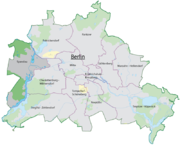 |
|---|---|---|---|---|
 (0501) Spandau (0501) SpandauSpandau (locality) Spandau is a locality of Berlin in the homonymous borough of Spandau. The historic city is situated, for the most part, on the western banks of the Havel river. As of 2008 the estimated population of Spandau was 33,433.-Position:... |
8.03 | 33,433 | 4,164 | |
 (0502) Haselhorst (0502) HaselhorstHaselhorst Haselhorst is a locality in the borough of Spandau in Berlin. It is located between Siemensstadt and the Old Town of Spandau and is separated from the Hakenfelde locality by the River Havel.-Overview:... |
4.73 | 13,668 | 2,891 | |
 (0503) Siemensstadt (0503) SiemensstadtSiemensstadt The Siemensstadt Housing Estate is a nonprofit residential community in the Charlottenburg-Wilmersdorf district of Berlin. It is one of the six Modernist Housing Estates in Berlin recognized in July 2008 by UNESCO as a World Heritage Site.-Geography:... |
5.66 | 11,388 | 2,012 | |
 (0504) Staaken (0504) StaakenStaaken Staaken is a locality at the western rim of Berlin within the borough of Spandau. In the west it shares border with the Brandenburg municipalities of Falkensee and Dallgow-Döberitz in the Havelland district. Buildings range from small detached houses in the west to larger 1960s and 1970s housing... |
10.90 | 41,470 | 3,810 | |
 (0505) Gatow (0505) GatowGatow Gatow, a district of south-western Berlin is located west of the Havelsee lake and has forested areas within its boundaries. It is within the borough of Spandau. On 31 December 2002, it had 5,532 inhabitants.-History:... |
10.10 | 3,908 | 386 | |
 (0506) Kladow (0506) KladowKladow -Geography:The district of Kladow is bordered by the District of Gatow to the north, by the Havel to the east and southeast and by the State of Brandenburg to the west and south west. The neighbouring village of Sacrow and main part of Groß Glienicke are located in Brandenburg... |
14.80 | 13,628 | 922 | |
 (0507) Hakenfelde (0507) HakenfeldeHakenfelde Hakenfelde is a German locality of Berlin in the borough of Spandau.-History:The name Hakenfelde is derived a dairy-farm built in 1730 on the outskirts of Spandau. Part of the town of Spandau it merged into Berlin in 1920 with the "Greater Berlin Act"... |
20.40 | 26,337 | 1,292 | |
 (0508) Falkenhagener Feld (0508) Falkenhagener FeldFalkenhagener Feld Falkenhagener Feld is a German locality of Berlin in the borough of Spandau.-History:The project to build a residential complex in the rural area of west Spandau and close to the village of Falkenhagen, started in 1962 . The locality, situated at the borders of West Berlin with East Germany, was... |
6.88 | 34,778 | 5,056 | |
 (0509) Wilhelmstadt (0509) WilhelmstadtWilhelmstadt Wilhelmstadt is a German locality of Berlin in the borough of Spandau.-History:In the year 1945 the allied armed forces from the Soviet Union and the United Kingdom accomplished an exchange of territory, among the area of Seeburg in Spandau... |
10.40 | 37,080 | 3,558 |
(06) Steglitz-Zehlendorf
Steglitz-Zehlendorf
Steglitz-Zehlendorf is the sixth borough of Berlin, formed in Berlin's 2001 administrative reform by merging the former boroughs of Steglitz and Zehlendorf.-Demographics:...
| Locality | Area in km² |
Population as of 2008 |
Density inhabitants per km² |
|
|---|---|---|---|---|
| (0601) Steglitz Steglitz Steglitz is a locality of the Steglitz-Zehlendorf borough in the south-west of Berlin, the capital of Germany. The locality also includes the neighbourhood of Südende.-History:... |
6.79 | 70,555 | 10,391 | |
 (0602) Lichterfelde (0602) LichterfeldeLichterfelde (Berlin) Lichterfelde is a locality in the borough of Steglitz-Zehlendorf in Berlin, Germany. Until 2001 it was part, with Steglitz and Lankwitz of the former Steglitz borough.-History:... |
18.20 | 78,338 | 4,300 | |
 (0603) Lankwitz (0603) LankwitzLankwitz Lankwitz is a German locality within the borough of Steglitz-Zehlendorf, Berlin. Until 2001 it was part of the former borough of Steglitz.-History:The locality was first mentioned in 1239 with the name of Lankowice... |
6.99 | 40,385 | 5,778 | |
| (0604) Zehlendorf Zehlendorf (Berlin) Zehlendorf is a locality within the borough of Steglitz-Zehlendorf in Berlin. Before Berlin's 2001 administrative reform Zehlendorf was a borough in its own right, consisting of the locality of Zehlendorf as well as Wannsee, Nikolassee and Dahlem... |
18.80 | 57,902 | 3,075 | |
 (0605) Dahlem (0605) DahlemDahlem (Berlin) Dahlem is a locality of the Steglitz-Zehlendorf borough in southwestern Berlin. Until Berlin's 2001 administrative reform it was a part of the former borough of Zehlendorf. Dahlem is one of the most affluent parts of the city and home to the main campus of the Free University of Berlin with the... |
8.39 | 14,966 | 1,784 | |
 (0606) Nikolassee (0606) NikolasseeNikolassee Nikolassee is a locality of Berlin in the borough of Steglitz-Zehlendorf. Until the latter was created in 2001, Nikolassee was part of the borough of Zehlendorf.-History:... |
19.60 | 15,899 | 811 | |
 (0607) Wannsee (0607) WannseeWannsee Wannsee is a locality in the southwestern Berlin borough of Steglitz-Zehlendorf, Germany. It is the westernmost locality of Berlin. In the quarter there are two lakes, the larger Großer Wannsee and the Kleiner Wannsee , are located on the river Havel and are separated only by the Wannsee bridge... |
23.70 | 9,044 | 382 |
(07) Tempelhof-Schöneberg
Tempelhof-Schöneberg
Tempelhof-Schöneberg is the seventh borough of Berlin, formed in 2001 by merging the former boroughs of Tempelhof and Schöneberg.-Geography:...
| Locality | Area in km² |
Population as of 2008 |
Density inhabitants per km² |
 |
|---|---|---|---|---|
| (0701) Schöneberg Schöneberg Schöneberg is a locality of Berlin, Germany. Until Berlin's 2001 administrative reform it was a separate borough including the locality of Friedenau. Together with the former borough of Tempelhof it is now part of the new borough of Tempelhof-Schöneberg.... |
10.60 | 116,743 | 11,003 | |
| (0702) Friedenau Friedenau Friedenau is a locality within the borough of Tempelhof-Schöneberg in Berlin, Germany. Per population density it is the highest one into the city.- Etymology :... |
1.65 | 26,736 | 16,204 | |
| (0703) Tempelhof Tempelhof Tempelhof is a locality of Berlin within the borough of Tempelhof-Schöneberg. It is the location of the former Tempelhof Airport, one of the earliest commercial airports in the world. It is now deserted and shows as a blank spot on maps of Berlin. Attempts are being made to save the still-existing... |
12.20 | 54,382 | 4,458 | |
 (0704) Mariendorf (0704) MariendorfMariendorf Mariendorf is a locality in the southern Tempelhof-Schöneberg borough of Berlin.- Geography :Mariendorf is situated between the localities of Tempelhof in the north and Marienfelde and Lichtenrade in the south... |
9.38 | 48,882 | 5,211 | |
 (0705) Marienfelde (0705) MarienfeldeMarienfelde Marienfelde is a locality in southwest Berlin. It is a mixed industrial and residential area, and part of the borough of Tempelhof-Schöneberg.-Transportation and industry:... |
9.15 | 30,151 | 3,295 | |
 (0706) Lichtenrade (0706) LichtenradeLichtenrade Lichtenrade is a German locality within the borough of Tempelhof-Schöneberg, Berlin. Until 2001 it was part of the former borough of Tempelhof.-History:The locality was first mentioned in 1375, named Lichtenrode... |
10.10 | 49,451 | 4,896 |
(08) Neukölln
Neukölln
Neukölln is the eighth borough of Berlin, located in the southeastern part of the city and was part of the former American sector under the Four-Power occupation of the city...
| Locality | Area in km² |
Population as of 2008 |
Density inhabitants per km² |
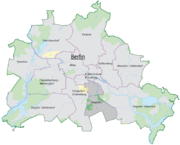 |
|---|---|---|---|---|
 (0801) Neukölln (0801) NeuköllnNeukölln (locality) Neukölln is an inner-city locality of Berlin in the homonymous borough of Neukölln, including the historic village of Rixdorf and numerous Gründerzeit apartment blocks. The Ortsteil is densely settled a with a population of 154,127 inhabitants and is the most populated one of Berlin... |
11.70 | 154,127 | 13,173 | |
 (0802) Britz (0802) BritzBritz Britz is a German locality within the Berlin borough of Neukölln.-History:The village of Britzig was first mentioned in 1273. It was incorporated by the 1920 Greater Berlin Act... |
12.40 | 38,334 | 3,091 | |
 (0803) Buckow (0803) BuckowBuckow (Berlin) Buckow is a locality within the Berlin borough of Neukölln.-History:The village was founded in 1373 by German settlers probably at the place of an earlier Wends' village of the name Buk spelled along with its patronymic suffix -ow... |
6.35 | 38,018 | 5,987 | |
 (0804) Rudow (0804) RudowRudow Rudow is a locality within the Berlin borough of Neukölln.-History:The village was founded in 1373. Until 1920 it was a municipality of the former Teltow district, merged into Berlin with the "Greater Berlin Act"... |
11.80 | 41,040 | 3,478 | |
 (0805) Gropiusstadt (0805) GropiusstadtGropiusstadt Gropiusstadt is a locality within the Berlin borough of Neukölln. It was named after the architect who projected the complex: Walter Gropius.-History:... |
2.66 | 35,844 | 13,475 |
(09) Treptow-Köpenick
Treptow-Köpenick
Treptow-Köpenick is the ninth borough of Berlin, Germany, formed in Berlin's 2001 administrative reform by merging the former boroughs of Treptow and Köpenick.-Overview:...
| Locality | Area in km² |
Population as of 2008 |
Density inhabitants per km² |
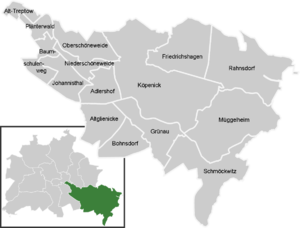 |
|---|---|---|---|---|
| (0901) Alt-Treptow Alt-Treptow Alt-Treptow is a German locality in the borough of Treptow-Köpenick in Berlin. Known also as Treptow it was, until 2001, the main and the eponymous locality of the former Treptow borough.-History:... |
2.31 | 10,426 | 4,513 | |
 (0902) Plänterwald (0902) PlänterwaldPlänterwald Plänterwald is a German locality within the Berlin borough of Treptow-Köpenick. Until 2001 it was part of the former borough of Treptow and the site of its former town hall .-History:... |
3.01 | 10,618 | 3,528 | |
 (0903) Baumschulenweg (0903) BaumschulenwegBaumschulenweg Baumschulenweg is a German locality within the Berlin borough of Treptow-Köpenick. Until 2001 it was part of the former borough of Treptow... |
4.82 | 16,780 | 3,481 | |
| (0904) Johannisthal Johannisthal (Berlin) Johannisthal is a German locality within the Berlin borough of Treptow-Köpenick. Until 2001 it was part of the former borough of Treptow.-History:The first mention of the locality was on November 16, 1753... |
6.54 | 17,650 | 2,699 | |
 (0905) Niederschöneweide (0905) NiederschöneweideNiederschöneweide Niederschöneweide is a German locality within the Berlin borough of Treptow-Köpenick. It is, with Oberschöneweide , part of the geographic quarter of Schöneweide... |
3.49 | 10,043 | 2,878 | |
 (0906) Altglienicke (0906) AltglienickeAltglienicke Altglienicke is a locality of Berlin in the district of Treptow-Köpenick. Until 2001 it was par of the former borough of Treptow.-History:The village of Glinik was first mentioned in 1375... |
7.89 | 26,101 | 3,308 | |
 (0907) Adlershof (0907) AdlershofAdlershof -External links:*... |
6.11 | 15,112 | 2,473 | |
 (0908) Bohnsdorf (0908) BohnsdorfBohnsdorf Bohnsdorf is a district in the borough Treptow-Köpenick of Berlin, Germany. It is located in the south-east of the city.-Position:The locality is situated in the southeastern suburb of Berlin and borders with Altglienicke, Grünau, and with the municipality of Schönefeld, in the Brandenburg district... |
6.52 | 10,751 | 1,649 | |
| (0909) Oberschöneweide Oberschöneweide Oberschöneweide is a German locality within the Berlin borough of Treptow-Köpenick. It is, with Niederschöneweide , part of the geographic area of Schöneweide... |
6.18 | 17,094 | 2,766 | |
| (0910) Köpenick Köpenick Köpenick is a historic town and locality that is situated at the confluence of the rivers Dahme and Spree in the south-east of the German capital city of Berlin. It was formerly known as Copanic and then Cöpenick, only officially adopting the current spelling in 1931... |
34.90 | 59,201 | 1,695 | |
| (0911) Friedrichshagen Friedrichshagen Friedrichshagen is a German locality within the Berlin borough of Treptow-Köpenick. Until 2001 it was part of the former borough of Köpenick.-History:... |
14.00 | 17,285 | 1,233 | |
| (0912) Rahnsdorf Rahnsdorf Rahnsdorf is a German locality within the Berlin borough of Treptow-Köpenick. Until 2001 it was part of the former borough of Köpenick.-History:... |
21.50 | 8,891 | 414 | |
 (0913) Grünau (0913) GrünauGrünau (Berlin) Grünau is a German locality within the Berlin borough of Treptow-Köpenick. Until 2001 it was part of the former borough of Köpenick.-History:... |
9.13 | 5,482 | 600 | |
| (0914) Müggelheim Müggelheim Müggelheim is a German locality within the Berlin borough of Treptow-Köpenick. Until 2001 it was part of the former borough of Köpenick.-History:... |
22.20 | 6,350 | 286 | |
| (0915) Schmöckwitz Schmöckwitz Schmöckwitz is a German locality within the Berlin borough of Treptow-Köpenick. Until 2001 it was part of the former borough of Köpenick.-History:The locality was founded in 1375 with the name of Smekewitz... |
17.10 | 4,117 | 240 |
(10) Marzahn-Hellersdorf
Marzahn-Hellersdorf
Marzahn-Hellersdorf is the tenth borough of Berlin, formed in 2001 by merging the former boroughs of Marzahn and Hellersdorf.-Geography:It is situated in the northeast of Berlin...
| Locality | Area in km² |
Population as of 2008 |
Density inhabitants per km² |
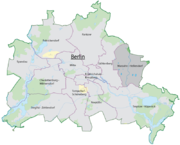 |
|---|---|---|---|---|
| (1001) Marzahn Marzahn Marzahn is a locality within the borough of Marzahn-Hellersdorf in Berlin. Berlin's 2001 administrative reform led to the former boroughs of Marzahn and Hellersdorf fusing into a single new borough... |
19.50 | 102,398 | 5,240 | |
 (1002) Biesdorf (1002) BiesdorfBiesdorf (Berlin) Biesdorf is a locality within the Berlin borough of Marzahn-Hellersdorf. Until 2001 it was part of the former borough of Marzahn.-History:... |
12.40 | 24,543 | 1,973 | |
 (1003) Kaulsdorf (1003) Kaulsdorf |
8.81 | 18,732 | 2,126 | |
| (1004) Mahlsdorf Mahlsdorf Mahlsdorf is a locality within the Berlin borough of Marzahn-Hellersdorf. Until 2001 it was part of the former borough of Hellersdorf.-History:... |
12.90 | 26,852 | 2,075 | |
| (1005) Hellersdorf Hellersdorf Hellersdorf is a locality in the borough of Marzahn-Hellersdorf in Berlin. Between 1986 and Berlin's 2001 administrative reform, it was a borough in its own right, consisting of the current area of Hellersdorf as well as Kaulsdorf and Mahlsdorf.-History:... |
8.10 | 72,602 | 8,963 |
(11) Lichtenberg
Lichtenberg
Lichtenberg is the eleventh borough of Berlin, Germany. In Berlin's 2001 administrative reform it absorbed the former borough of Hohenschönhausen.-Overview:...
| Locality | Area in km² |
Population as of 2008 |
Density inhabitants per km² |
|
|---|---|---|---|---|
| (1101) Friedrichsfelde Friedrichsfelde Friedrichsfelde is a German locality within the borough of Lichtenberg, Berlin.-History:The locality was first mentioned in a document of 1265 with the name of Rosenfelde. In 1699 it was renamed Friedrichsfelde after the Prince-Elector Frederick III of Brandenburg... |
5.55 | 50,010 | 9,011 | |
 (1102) Karlshorst (1102) KarlshorstKarlshorst Karlshorst is a locality in the borough of Lichtenberg in Berlin. It houses a harness racing track and the Hochschule für Technik und Wirtschaft Berlin , the largest University of Applied Sciences in Berlin, and the German-Russian Museum Berlin-Karlshorst.-History:Established in 1895 as the... |
6.60 | 21,329 | 3,232 | |
| (1103) Lichtenberg Lichtenberg (locality) Lichtenberg is a locality of Berlin in the homonymous district of Lichtenberg. Until 2001 it was an autonomous district with the localities of Fennpfuhl, Rummelsburg, Friedrichsfelde and Karlshorst.- History :... |
7.22 | 32,295 | 4,473 | |
 (1104) Falkenberg (1104) FalkenbergFalkenberg (Berlin) Falkenberg is a German locality within the borough of Lichtenberg, Berlin. Until 2001 it was part of the former borough of Hohenschönhausen.-History:... |
3.06 | 1,164 | 380 | |
 (1106) Malchow (1106) MalchowMalchow (Berlin) Malchow is a German locality in the borough of Lichtenberg, Berlin. Until 2001 it was part of the former Hohenschönhausen borough. With a population of 450 it is the least-populated Berliner Ortsteil.-History:... |
1.54 | 450 | 292 | |
 (1107) Wartenberg (1107) WartenbergWartenberg (Berlin) Wartenberg is a German locality within the borough of Lichtenberg, Berlin. Until 2001 it was part of the former borough of Hohenschönhausen.-History:... |
6.92 | 2,433 | 352 | |
 (1109) Neu-Hohenschönhausen (1109) Neu-HohenschönhausenNeu-Hohenschönhausen Neu-Hohenschönhausen is a German locality in the borough of Lichtenberg, Berlin. Until 2001 it was part of the former Hohenschönhausen borough.-History:... |
5.16 | 53,698 | 10,407 | |
| (1110) Alt-Hohenschönhausen Alt-Hohenschönhausen Alt-Hohenschönhausen is a German locality in the borough of Lichtenberg, Berlin. Known also as Hohenschönhausen it was, until 2001, the main and the eponymous locality of the former Hohenschönhausen borough.-History:The locality, first mentioned in 1230, was an autonomous municipality still... |
9.33 | 41,780 | 4,478 | |
 (1111) Fennpfuhl (1111) FennpfuhlFennpfuhl Fennpfuhl is a German locality in the borough of Lichtenberg, Berlin. With a population of 30,932 in an area of , it is the second most densely populated locality in Berlin after Friedenau.-History:... |
2.12 | 30,932 | 14,591 | |
 (1112) Rummelsburg (1112) RummelsburgRummelsburg Rummelsburg is a German locality in the borough of Lichtenberg, Berlin.-History:The locality was founded in 1669 and on January 30, 1889 became a rural municipality, with the name of Boxhagen-Rummelsburg... |
4.52 | 17,567 | 3,887 |
- Codes 1105 and 1108 (this one to former HohenschönhausenHohenschönhausenHohenschönhausen was a borough of Berlin, that existed from 1985 until Berlin's 2001 administrative reform. It was composed by the localities of Alt-Hohenschönhausen , Neu-Hohenschönhausen, Malchow, Wartenberg and Falkenberg.-Overview:...
locality) are not assigned
(12) Reinickendorf
Reinickendorf
Reinickendorf is the twelfth borough of Berlin. It encompasses the northwest of the city area, including the Berlin-Tegel Airport, Lake Tegel, spacious settlements of detached houses as well as housing estates like Märkisches Viertel.-Subdivision:...
| Locality | Area in km² |
Population as of 2008 |
Density inhabitants per km² |
|
|---|---|---|---|---|
 (1201) Reinickendorf (1201) ReinickendorfReinickendorf (locality) Reinickendorf is a locality of Berlin in the borough of Reinickendorf. It had a population of 72,859 in 2008.-Geography:... |
10.50 | 72,859 | 6,939 | |
 (1202) Tegel (1202) TegelTegel Tegel is a locality in the Berlin borough of Reinickendorf on the shore of Lake Tegel. The Tegel locality, the second largest in area of the 95 Berlin districts, also includes the neighbourhood of Saatwinkel.-History:... |
33.70 | 33,417 | 992 | |
 (1203) Konradshöhe (1203) KonradshöheKonradshöhe Konradshöhe is a German locality within the borough of Reinickendorf, Berlin.-History:In the course of the northern extension of Berlin during the 19th century, many people settled in the suburbs, attracted by the proximity to nature and the low price of land. One of them was the coppersmith... |
2.20 | 5,997 | 2,726 | |
| (1204) Heiligensee Heiligensee Heiligensee is a locality within Reinickendorf, a borough of the German capital, Berlin. It has 17,780 inhabitants and an area of .-Overview:... |
10.70 | 17,641 | 1,649 | |
| (1205) Frohnau Frohnau Frohnau is a locality in the Reinickendorf borough of Berlin, Germany. It lies in the extreme northern part of the city.- History :Founded in 1910, Frohnau was created whole as a planned community, corresponding to the early twentieth century idea of a Garden City... |
7.80 | 17,025 | 2,183 | |
| (1206) Hermsdorf Hermsdorf (Berlin) Hermsdorf is a district of Berlin located in the borough of Reinickendorf.-History:First mentioned in 1200, it was an autonomous municipality merged into Berlin in 1920 with the "Greater Berlin Act"... |
6.10 | 16,503 | 2,705 | |
 (1207) Waidmannslust (1207) WaidmannslustWaidmannslust Waidmannslust is a German locality within the borough of Reinickendorf, Berlin.-History:The locality was created in 1875 as a Villenkolonie . In 1920 it merged in the city of Berlin with the Greater Berlin Act. During the period 1949–1990 it was part of the French sector of West Berlin. Some... |
2.30 | 10,022 | 4,357 | |
 (1208) Lübars (1208) LübarsLübars Lübars is a German locality within the borough of Reinickendorf, Berlin.-History:First mentioned in 1247, it was an autonomous municipality merged into Berlin in 1920 with the "Greater Berlin Act". As a part of West Berlin bordering East Germany, Lübars was crossed, from 1961 to 1989, by the... |
5.00 | 4,915 | 983 | |
 (1209) Wittenau (1209) WittenauWittenau Wittenau is a German locality within the borough of Reinickendorf, Berlin.-History:Originally named Dalldorf it was first mentioned in 1332... |
8.00 | 28,384 | 3,548 | |
 (1210) Märkisches Viertel (1210) Märkisches ViertelMärkisches Viertel Märkisches Viertel is a German locality in the borough of Reinickendorf in Berlin.-Overview:It consists of a large housing estate of about 17,000 apartments with chains of high-rises up to 16 floors that were built from 1964 to 1974 by the GeSoBau Gesellschaft für sozialen Wohnungsbau... |
3.20 | 35,206 | 11,002 |

